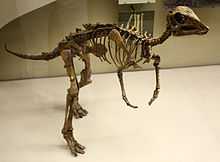Arstanosaurus
| Arstanosaurus Temporal range: Late Cretaceous | |
|---|---|
 | |
| Juvenile hadrosaur assigned to Arstanosaurus sp. | |
| Scientific classification | |
| Kingdom: | Animalia |
| Phylum: | Chordata |
| Class: | Sauropsida |
| Superorder: | Dinosauria |
| Order: | Ornithischia |
| Family: | ?Hadrosauridae |
| Genus: | Arstanosaurus Shilin & Suslov, 1982 |
| Binomial name | |
| Arstanosaurus akkurganensis Shilin & Suslov, 1982 | |
Arstanosaurus (meaning "Arstan lizard" after the Arstan well) is a genus of hadrosaurid dinosaur from the Santonian-Campanian-age Upper Cretaceous Bostobinskaya Formation, Kazakhstan. It has had a confusing history, being considered both a hadrosaurid and a ceratopsid, or both at the same time (chimeric).
History
The genus was based on a partial left maxilla (holotype AAIZ 1/1 or IZ AN KSSR 1/1), with the lower end of a left femur (AAIZ 1/2) possibly referable. Both were found at Akkurgan-Boltyk near Qyzylorda.[1] This is not much material for naming a new genus, and it was largely ignored until the mid-1990s, when the hypothesis that it was really a ceratopsid appeared.[2] Shortly thereafter, a new revision appeared that showed that the characteristics listed as unusual for Arstanosaurus were really based on perspective, and that the maxilla was from an animal like Bactrosaurus, albeit indeterminate (a dubious name). The femur was uninformative.[3] It was regarded as an indeterminate hadrosaurid in the most recent review.[4]
A juvenile skeleton from Mongolia has been attributed to Arstanosaurus, but on what grounds is unknown. It is under study.[5] It was formerly called "Gadolosaurus".[6]
Diagnostic hadrosauroid remains from the same area have in 2012 been named as Batyrosaurus.[7]
Paleobiology
As a hadrosaurid, Arstanosaurus would have been a bipedal/quadrupedal herbivore, eating plants with sets of ever-replacing teeth stacked on each other.[4]
References
- ↑ Shilin, F.V., and Suslov, Y.V. (1982). A hadrosaur from the northeastern Aral Region. Paleontological Journal 1982(1):132-136 [translated version].
- ↑ Nesov, L.A. (1995). Dinozavri severnoi Yevrasii: Novye dannye o sostave kompleksov, ekologii i paleobiogeografii [Dinosaurs of Northern Eurasia: new data about assemblages, ecology and paleobiogeography]. Scientific Research Institute of the Earth's Crust. St. Petersburg State University:St. Petersburg, Russia, 156 pp. + 14 pl. [Russian].
- ↑ Norman, D.B., and Kurzanov, S.M. (1982). On Asian ornithopods (Dinosauria: Ornithischia). 2. Arstanaosaurus akkurganensis Shilin and Suslov, 1982. Proceedings of Geologists' Association 108(3):191-199.
- ↑ 4.0 4.1 Horner, J.R., Weishampel, D.B., and Forster, C.A. (2004). Hadrosauridae. In: Weishampel, D.B., Dodson, P., and Osmólska, H. (eds.). The Dinosauria (second edition). University of California Press:Berkeley, 438-463. ISBN 0-520-06727-4.
- ↑ Norman, D.B., and Sues, H.-D. (2000). Ornithopods from Kazakhstan, Mongolia and Siberia. In: Benton, M.J., Shishkin, M.A., Unwin, D.M., and Kurochkin, E.N. (Eds.). The Age of Dinosaurs in Russia and Mongolia. Cambridge University Press:Cambridge, 462-479. ISBN 0-521-55476-4.
- ↑ Lambert, David; and the Diagram Group (1990). The Dinosaur Data Book. New York: Avon Books. p. 63. ISBN 0-380-75896-2.
- ↑ Pascal Godefroit, François Escuillié, Yuri L. Bolotsky & Pascaline Lauters, 2012, "A New Basal Hadrosauroid Dinosaur from the Upper Cretaceous of Kazakhstan". In: Godefroit, P. (eds). Bernissart Dinosaurs and Early Cretaceous Terrestrial Ecosystems. Indiana University Press. pp. 335–362